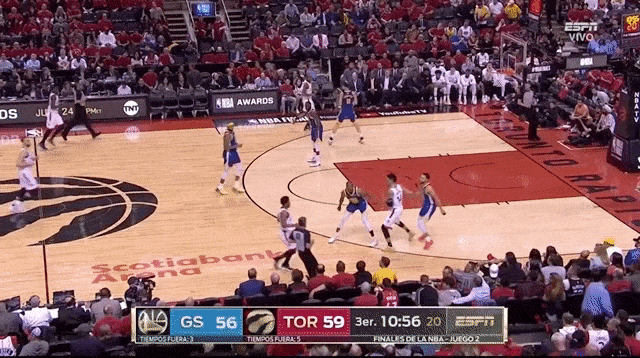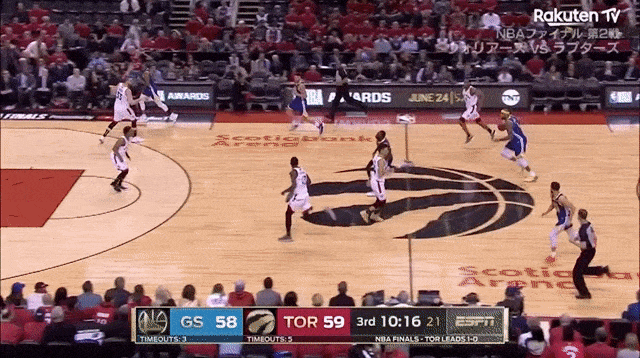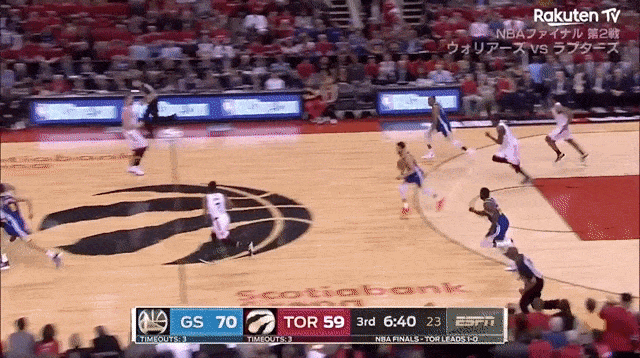TORONTO — You ever wonder what it feels like? You know, when the Golden State Warriors go on one of those epic, dizzying, shoot-the-lights out runs. When it seems like every time they’re up the floor someone’s open, someone’s getting to the rim, someone’s putting the ball in the basket.
And at the other end, your offence is frozen over. You can’t find a shooter, you can’t make the right pass, you can’t create the space you need. And every time you force a look, or you brick a tough shot, or you cough it up, there they go again, off to the races in transition. When the points are flying up on the board, and you’re feeling a game slip away, and the walls of the arena are rapidly closing in, what’s it like?
“It seemed like we were kind of sloppy — like we kind of forgot how to play basketball for a second,” said Danny Green, the Toronto Raptors guard, after his team dropped Game 2 of the NBA Finals to those high-flying Warriors, 109-104. “It was kind of like pick-up.”
It definitely looked like it. After Toronto took a five-point lead into halftime, Golden State came out of the dressing room in blitzkrieg mode, going 8-of-12 over the first five minutes and 40 seconds of the third quarter before the Raptors even scored a point.
It was ultimately an 18-0 run, which now stands as the biggest to begin a half in NBA Finals history. And if you include the two points the Warriors scored at the end of the second quarter, the 20-0 run becomes the biggest ever in an NBA Finals game. It swung a seven-point Raptors lead into a 13-point deficit.
“That was pretty much the game right there,” said Kawhi Leonard, who was on the floor for all of it and took a minus-13 in the quarter despite scoring 12 points himself. “You can’t do that with a championship team on the other side.”
Of course, this is what Golden State does. The Warriors have been the league’s best third quarter team by net rating every season from 2014-15 through to this one. Their offensive ratings in third quarters over the last three seasons look like clerical errors. This season, they averaged 119.2 pointers per 100 possessions in third quarters, more than four points higher than their league-best 114.9 rate for entire games.
| Season | OFF Rating | DEF rating | NET rating |
|---|---|---|---|
| 2014-15 | 116.0 (1st) | 101.5 (6th) | 14.5 (1st) |
| 2015-16 | 112.7 (4th) | 99.8 (2nd) | 12.9 (1st) |
| 2016-17 | 123.3 (1st) | 100.3 (1st) | 23.0 (1st) |
| 2017-18 | 119.8 (1st) | 102.4 (2nd) | 17.4 (1st) |
| 2018-19 | 119.2 (1st) | 107.5 (6th) | 11.7 (1st) |
There’s no explaining it in terms of process or measures. The Warriors don’t drink a magic juice or recite a voodoo chant at halftime. Other teams can’t replicate this. But at some point — like, say, five consecutive years of third quarter dominance — it isn’t an anomaly. Golden State just has a way of running away with games in the time between the 24th minute and the 36th.
“And we knew that,” Green said. “We’ve just got to do a better job of sustaining and keeping our lead.
“We’ve got to play 48 minutes. This is the NBA Finals. We can’t have lulls, we can’t have lapses. Especially against a team like that. That third quarter really hurt us.”
It actually started well, as Marc Gasol blocked Golden State’s first attempt at the rim, after DeMarcus Cousins beat him into the paint with a spin move. The Raptors then forced a shot clock violation, and settled for a contested Leonard jumper at the other end, which wasn’t an ideal look but wasn’t horrific, either.
But it was the next trip up the floor when the wheels came off. Andre Iguodala hit a mid-range two before Kyle Lowry threw a lazy entry pass to Green, who quickly tried to force the ball out of the predicament he was in and couldn’t get it through Golden State traffic:

That let the Warriors get out in transition, where they’re killers — and Curry quickly found a floater in the paint. That’s when Toronto’s offence stalled, and Leonard missed a fadeaway jumper late in the shot clock, letting Golden State get out quickly again, with big centre Cousins of all people running the floor. This time, Iguodala is left alone in the corner, where he drilled an unacceptably wide-open three to give his team the lead:

Raptors head coach Nick Nurse called an early break to try to settle things down, but Gasol was flagged for an iffy offensive foul on a screen during Toronto’s out-of-timeout play, and another defensive breakdown let Draymond Green get to the rim uncontested.
Lowry was stripped at the other end, which led to a Curry miss, before he was stripped again, this time in his own half court for Toronto’s fourth turnover in 93 seconds of game time. More Raptors misses, more Warriors makes, another offensive foul by Gasol, and another timeout by Nurse later, the Raptors were suddenly down by nine.
This time, the out-of-timeout play generated a Pascal Siakam look in the paint that was blocked from behind, letting Golden State score in transition again. Another trip up the floor, another Siakam miss in the paint, another Warriors opportunity in transition which led to Green simply running right up the flank of Toronto’s defence on his way to the paint:

“Yeah, I mean, overall I think we just started too slow. You can’t do that against this team,” said Fred VanVleet, who hit a three with 6:20 on the clock to give Toronto its first points of the quarter. “Missing every shot doesn’t help — whatever it was, 10 possessions in a row we didn’t score. I’m not even sure. It didn’t feel like we were even getting in the paint to control the tempo or the flow of the game.
“So, they jumped out on us and it was hard to get back set after that. You’ve got to score against this team. I mean, 21 points in the third quarter is not going to do it. Our offence has got to be better.”
That the Raptors even scored those 21 in the quarter, and lost it by only 13, is a minor accomplishment considering how disastrously things went over the first six minutes. From VanVleet’s three-pointer on, the Raptors won the remainder of the quarter, 21-16. But the damage was done.
Of course, the Raptors are not the first team to experience one of Golden State’s latter-half sieges on this stage. At this time last year, the Warriors essentially rode their third-quarter dominance to a second consecutive title.
Over the course of 21 games in the 2018 playoffs, the Warriors outscored opponents by 153 points in third quarters, with 50 of those points coming in series-deciding games. In eight of their 11 contests over the final two rounds against the Houston Rockets and Cleveland Cavaliers, the Warriors went into the third quarter either tied or trailing eight times. They won seven of those quarters.
And then there was this year’s Western Conference Finals, which the Warriors won in a sweep of the Portland Trail Blazers despite trailing three of the games by 17. The Warriors won the third quarter of the second game in that series by 15, and the third quarter of the third game by 16.
The Raptors knew this coming into the series, they talked about it as they prepared, and you can bet they mentioned it in the dressing room at halftime of both of the games played so far during these NBA Finals. But knowing that Warriors push is coming is one thing. Stopping it is another.
“We’ve got to be better to start the third and we know that — that’s something that we’ll focus on and look at the tape and see how we can be better next game,” VanVleet said. “When we have good offence and we’re able to get our defence set, we can live with that. But when we’re turning the ball over and not getting good shots and not making any shots and you’ve got to guard those guys in transition every play, it gets tough. And that’s what you saw.”
[relatedlinks]








